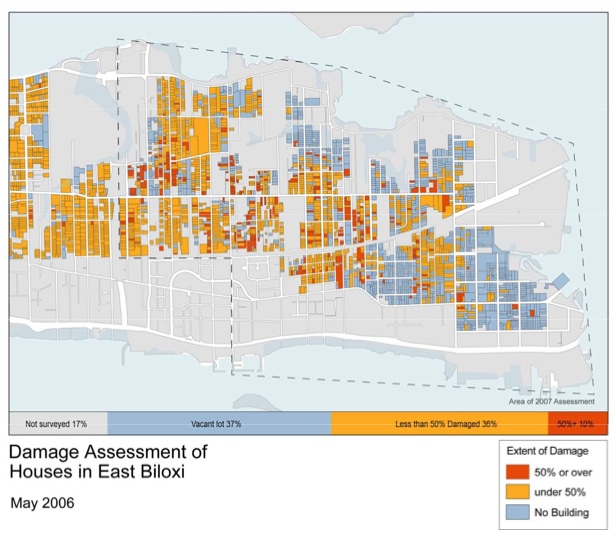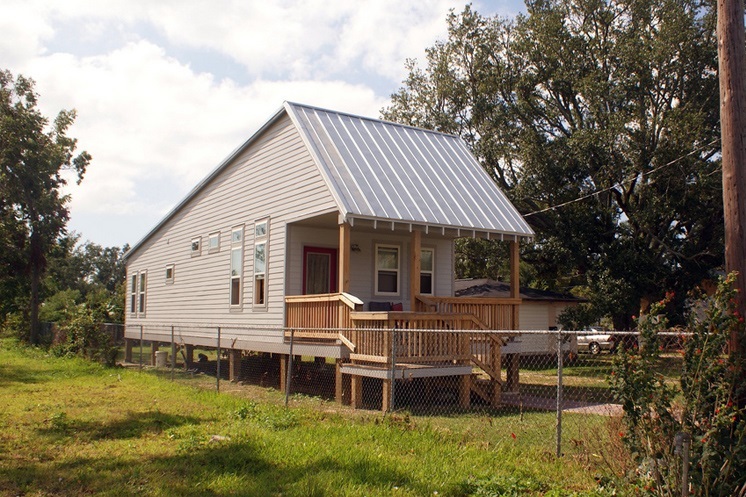IN THIS ISSUE:
Grantee Spotlight: Universities Share Housing Counseling with Their Communities and Each Other
Community (Re)Building in East Biloxi, Mississippi
Anchor Institutions: A Review of the Literature
Community (Re)Building in East Biloxi, Mississippi

Gulf Coast Design Studio staff produced a map detailing housing conditions and the extent of storm damage in East Biloxi. Image courtesy of Gulf Coast Community Design Studio.
“The first thing we did was to make maps,” recalls David Perkes, associate professor of architecture at Mississippi State University and founding director of the Gulf Coast Community Design Studio. Perkes was one of the many volunteers who traveled to East Biloxi, Mississippi following Hurricane Katrina to assist with emergency relief and recovery.
The maps prepared by Perkes and his colleagues detailed the extent of storm damage. They were used to make decisions about relief priorities and to track recovery efforts. In the eight years since the maps were created, the studio has played a critical role in rebuilding a more resilient Gulf Coast. Its community-based architectural practice engages students and professionals in design, planning, and research.
The studio is a product of Universities Rebuilding America Partnerships (URAP), a joint effort of HUD’s Office of University Partnerships and the Corporation for National and Community Service. URAP was launched immediately after hurricanes Katrina and Rita; the initiative included $2 million for design collaborations between affected communities and architectural and planning schools across the country. Of that total, a $300,000 grant helped seed Mississippi State University’s Gulf Coast Community Design Studio in East Biloxi.
Building Partnerships
Although the destruction caused by Hurricane Katrina in New Orleans captured much of the nation’s attention, in Mississippi, the storm destroyed or damaged tens of thousands of homes and left more than half of the state’s residents without power. As the storm hit the state, low-lying areas along the Gulf Coast suffered the most damage; more than 5,000 East Biloxi homes were flooded as the storm pushed a wall of water over the narrow peninsula. Many low-income residents faced the seemingly impossible challenge of rebuilding.
In the storm’s aftermath, the East Biloxi Coordination and Relief Center (known today as HOPE Community Development Agency) became the hub for local relief assistance. There, Perkes met then-city council member Bill Stallworth, founder of the relief center. “I asked the Lord for help in sending people our way,” recalls Stallworth. “And [I asked], you know, if it’s not too much trouble, can I have an architect? And David comes down, we meet, and it’s an answer to a prayer, as he brings several architects with him.”
The maps Perkes and his colleagues produced marked the beginning of a longstanding partnership that was formalized with a 2005 URAP grant. Perkes used the URAP funding along with other financial support to hire 12 architects to work with residents on rebuilding and repairing their homes. Studio staff focused on the technical aspects of design and construction, while the relief center provided outreach and case management services to residents and identified funds for rebuilding. “We were downstream from case management. . . . This allowed us to create a very efficient design process,” notes Perkes in discussing the division of labor between studio and relief center staff and volunteers.

Rebuilt homes in East Biloxi reflect the unique needs of residents and were designed to withstand severe weather. Image courtesy of Gulf Coast Community Design Studio.
The two organizations shared office space in an old church building and created a one-stop shop for residents who were ready to rebuild or repair their homes. According to Stallworth, this model of service simplified the process for residents. “Most people have never built a home before. The idea that people would be able to [build a home here on their own] would never work.”
The quality of homes created through the organizations’ collaboration has encouraged residents not to abandon East Biloxi. “[Some residents] now have the home that they have always wanted,” says Stallworth. “We looked at rebuilding and repair as an opportunity to make improvements.” These improvements include elevating structures above the floodplain and adding tie-downs and straps to help homes withstand heavy winds. Other improvements, such as high-efficiency mechanical systems and appliances, promote energy efficiency. “We were able to virtually customize [the rebuilt] homes” for residents, says Stallworth, which would not have been possible without the design services offered through the studio.
Stallworth estimates that the relief center has rebuilt approximately 125 homes and repaired around 850 others in East Biloxi. The design studio’s involvement in this work has ranged from full architectural drawings to more informal advisory services.
An Evolving Practice
Over time, the design studio began providing services to other communities along the Gulf Coast, integrating teaching and research as needed. Studio design courses began in spring 2007, well after the recovery began. “The grant was very flexible in terms of our scope of work and gave us the ability to adapt to changing needs,” says Perkes. Since receiving URAP funding, the studio has been awarded additional grants, and has expanded its practice, education, and research focus to include regional planning, natural resources planning, and resiliency along the Gulf Coast. The studio is a partner in the Mississippi Gulf Coast Sustainable Communities Initiative’s Plan for Opportunity. This regional planning grant from HUD promotes economic competitiveness in 15 jurisdictions along the Mississippi coast. The studio has also undertaken grant-funded bayou restoration projects and research on energy-efficient building design and flood-resilient construction.
Having gained experience in storm-resistant design and community-based planning in Mississippi’s Gulf Coast region, the studio is applying its expertise in disaster recovery to areas affected by Hurricane Sandy. The studio recently partnered with unabridged Architecture and Waggoner and Ball Architects to compete against nine other teams in Rebuild by Design. Sponsored by the Hurricane Sandy Rebuilding Task Force, the competition seeks rebuilding solutions that are resilient, scalable, and context sensitive. Winning designs will be implemented in 2014 with Disaster Recovery Assistance made available through HUD's Community Development Block Grant program.


